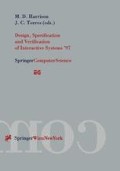Abstract
One way of assessing the usability of a computer system is to make reasonable assumptions about users’ cognition and to analyse how they can be expected to work with the system, using their knowledge and information from the display to achieve their goals. This is the approach taken in Programmable User Modelling Analysis, a technique for predictive usability evaluation of interactive systems. The technique is based on the premise that an analyst can gain insights into the usability of a computer system by specifying the knowledge that a user needs to be able to use it and drawing inferences on how that knowledge will guide the user’s behaviour. This may be done by observing how a cognitive architecture, “programmed” with that knowledge, behaves. An alternative approach is to develop a formal description of the essential features of the cognitive architecture and to use that description to reason about likely user behaviour. In this paper, we present the approach and an outline formal description of the cognitive architecture. This initial description is derived from an existing implementation. We illustrate how the description can be used in reasoning by applying it to the task of setting up call diverting on a mobile phone. Successful performance of this task involves a combination of planned and responsive behaviour. The process of doing this analysis highlights what assumptions have been made by the designers about the user’s knowledge. We discuss limitations of the current formalisation and identify directions for future work.
Access this chapter
Tax calculation will be finalised at checkout
Purchases are for personal use only
Preview
Unable to display preview. Download preview PDF.
References
BLANDFORD, A. E. & DUKE, D. J. (1997). Integrating user and computer system concerns in the design of interactive systems. International Journal of Human- Computer Studies, pp. 653 – 679.
BLANDFORD, A. E. & YOUNG, R. M. (1995) Separating User And Device Descriptions for Modelling Interactive Problem Solving. In K. Nordby, P. Helmersen, D J Gilmore, and S Arnesen (eds.): Human-Computer Interaction: Interact*95. Chapman and Hall, 1995. pp. 91 – 96.
BLANDFORD, A. E. & YOUNG, R. M. (1996) Specifying user knowledge for the design of interactive systems. Software Engineering Journal. 11. 6, 323 – 333.
BOWEN, J.P. & HINCHEY, M.G. (1995) Ten Commandments of Formal Methods. IEEE Computer. Vol 28 (4), pp. 56 – 63.
CARD, S. K., MORAN, T. P. AND NEWELL, A. (1983). The Psychology of Human Computer Interaction, Hillsdale: Lawrence Erlbaum.
DUKE, D.J. (1995) Reasoning About Gestural Interaction. Computer Graphics Forum, Vol 14(3). Proceedings of Eurographics’95. pp. 55–66. NCC/Blackwell
FACONTI, G.P. & DUKE, D.J. (1996) Device Models. In F. Bodart & J. Vanderdonckt (Eds.) Design, Specification and Verification of Interactive Systems’96. pp. 73 – 91. Vienna: Springer-Verlag.
JOHN, B. & KIERAS, D. (1996) The GOMS family of user interface analysis techniques: comparison and contrast. ACM Transactions on CHI., 3, 320 – 351.
KIERAS, D. & MEYER, D.E. (1995) An overview of the EPIC architecture for cognition and performance with application to human-computer interaction. (EPIC Tech. Rep. No. 5 (TR-95/ONR-EPIC-5). Ann Arbor, University of Michigan, Electrical Engineering and Computer Science Department.
KIERAS, D.E. & POLSON, P.G. (1985) An approach to the formal analysis of user complexity. International Journal of Man Machine Studies, 22, 365 – 394.
NEWELL, A. (1982) ‘The knowledge level’ Artificial Intelligence, 18, 87 – 127.
NEWELL, A. AND SIMON, H. (1972). Human Problem Solving, Englewood Cliffs, NJ: Prentice Hall.
PAYNE, S. J. AND GREEN, T.R.G. (1986). Task-Action Grammars: a model of mental representation of task languages. Human-Computer Interaction, 2, 93 – 133.
POLSON, P. & LEWIS, C. (1990) Theory based design for easily learned interfaces. Human Computer Interaction, 5, 191 – 220.
RYAN, M., FIADEIRO, J. & MAIBAUM, T. (1991) “Sharing Actions and Attributes in Modal Action Logic” in T. Ito and A. Meyer (Eds.) Theoretical Aspects of Computer Software. Springer Verlag.
YOUNG, R.M., GREEN, T.R.G. & SIMON, T. (1989) ‘Programmable user models for predictive evaluation of interface designs’ in Bice, K. and Lewis, C. (eds.) Proceedings of CHI ’89, 15 – 19, New York: ACM.
Author information
Authors and Affiliations
Editor information
Editors and Affiliations
Rights and permissions
Copyright information
© 1997 Springer-Verlag/Wien
About this paper
Cite this paper
Blandford, A., Butterworth, R., Good, J. (1997). Users as rational interacting agents: formalising assumptions about cognition and interaction. In: Harrison, M.D., Torres, J.C. (eds) Design, Specification and Verification of Interactive Systems ’97. Eurographics. Springer, Vienna. https://doi.org/10.1007/978-3-7091-6878-3_4
Download citation
DOI: https://doi.org/10.1007/978-3-7091-6878-3_4
Publisher Name: Springer, Vienna
Print ISBN: 978-3-211-83055-0
Online ISBN: 978-3-7091-6878-3
eBook Packages: Springer Book Archive

